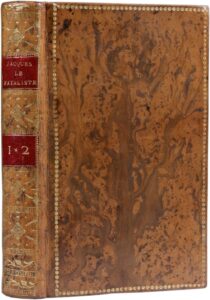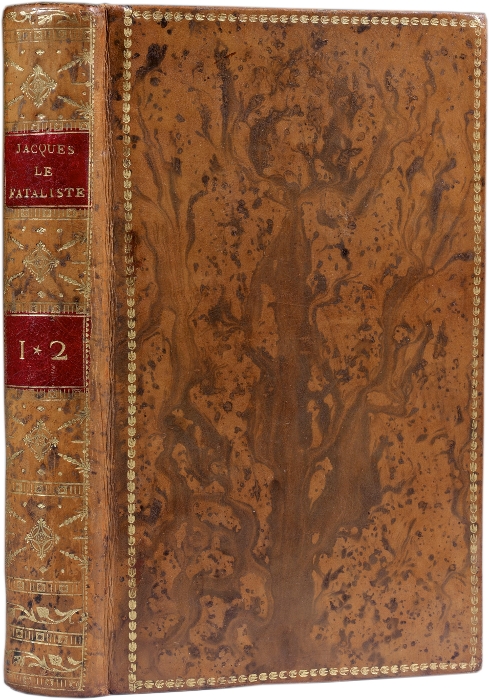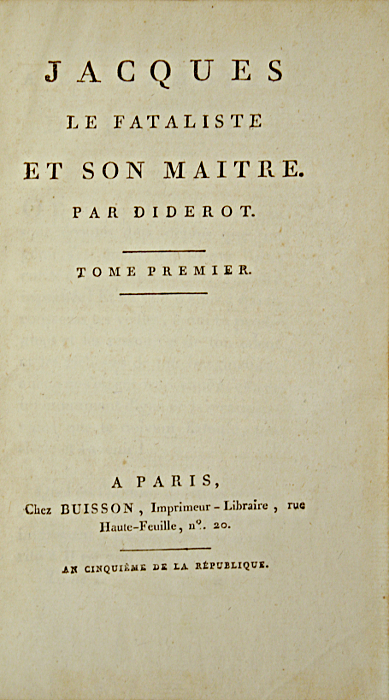DIDEROT, Denis. Jacques le Fataliste et son maitre. Paris, Buisson, An cinquième de la République [1796].
2 parts in 1 volume 8vo [193 x 114 mm]: (2) ll., xxii pp., pp. 23 to 286; (2) ll., 320 pp., very small burnhole in the white margin of p. 263. Bound in contemporary full calf in a design resembling tree roots, decorative gilt border on covers, flat spine decorated with gilt fleurons, red morocco lettering pieces, marbled edges. Contemporary binding.
Read more
First edition of Diderot’s famous philosophical tale. Adams, Bibliographie des Œuvres de Diderot, JF1; Tchemerzine, II, 965.
In 1765, Diderot is trying to sell his book collection in order to give his daughter a marriage settlement. The empress of Russia Catherine II purchases it but let Rousseau enjoy it during his all life. Invited in St-Petersburg, Diderot undertakes this travel when he is 60 in 1773. No sooner was he on the road than he started this novel; he spent 5 months at the Russian court and ended Jacques le fataliste during his stay in Russia. It was his last work of some importance.
Like most of Diderot’s works, this novel wasn’t published during his lifetime.
In Jacques le fataliste, Diderot poses the problem of freedom in an apparently casual form and thanks to the process of dialogue.
« Like ‘Le Neveu de Rameau’, ‘Jacques le fataliste’ is a long dialogue, but this dialogue contains all sorts of adventures, accounts, and very varied digressions […] This entirely original and peculiar novel, by its presentation and its spirit, reminds us of many novels from the 18th century: from ‘Le Diable boiteux’ by Lesage, to ‘Candide’ by Voltaire and also the ‘Vie et opinions de Tristram Shandy’ by Sterne. Diderot acknowledged that Sterne’s work was his main source. The colourfulness of many scenes, the freedom of speech and the keenness of narration also reveal the influence of Rabelais, of whom Diderot was always a fervent admirer. And Jacques is quite well looking like, by certain aspects, Panurge. Nevertheless the work stays one of the most original among French literature, by its actual apparent defects, – but they are wanted, concerted, – by the muddle of its episodes, the density of the subjects, the variety of digressions, which renew, page after page, its interest. It is certainly one of the works where is shown the most openly Diderot’s vigorous, paradoxical, generous and often great character. » (Dictionnaire des Œuvres, III, 765-766).
« This first edition does not include figures, some copies comprise some but they are added. » (Tchemerzine).
A fine wide-margined copy preserved in its contemporary elegant calf binding in a design resembling tree roots.
Provenance: from the princes of Starhemberg’s collection at Eferding castle (stamp and pencilled mark on titles).
See less information



